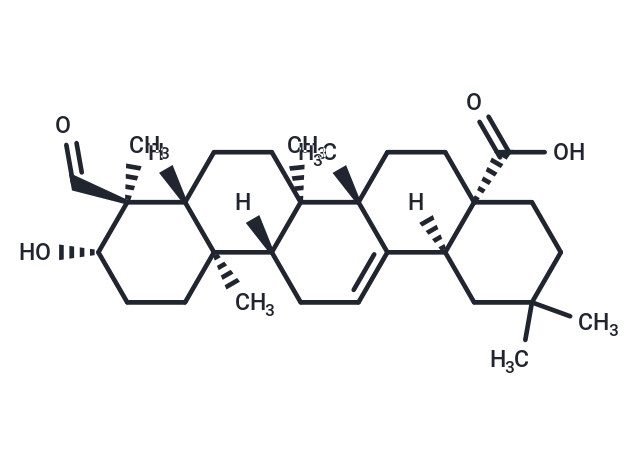Shopping Cart
Remove All Your shopping cart is currently empty
Your shopping cart is currently empty
Gypsogenin (639-14-5) is a naturally occurring biochemical that shows anti-ABL1 kinase and anti-chronic Myelogenous Leukemia activities.

| Pack Size | Price | USA Warehouse | Global Warehouse | Quantity |
|---|---|---|---|---|
| 1 mg | $136 | In Stock | In Stock | |
| 5 mg | $332 | In Stock | In Stock | |
| 10 mg | $493 | In Stock | In Stock | |
| 25 mg | $788 | In Stock | In Stock | |
| 50 mg | $1,120 | Inquiry | Inquiry | |
| 100 mg | $1,490 | Inquiry | Inquiry | |
| 1 mL x 10 mM (in DMSO) | $368 | In Stock | In Stock |
| Description | Gypsogenin (639-14-5) is a naturally occurring biochemical that shows anti-ABL1 kinase and anti-chronic Myelogenous Leukemia activities. |
| In vitro | Gypsogenin (1) was obtained by acidic hydrolysis from its saponin.?While the parent compound 1 acted as a selective inhibitor for butyrylcholinesterase (from equus) possessing a moderate mixed-type inhibition of the enzyme, Ki values as low as 2.67 0.59 μM were determined for (3β,4α) 3-O-acetyl-olean-12-ene-23,28-dinitrile (11) and acetylcholinesterase (AChE, from electric eel).?Thus, 11 possesses one-fifth of the inhibitory activity of the 'gold standard' galantamine hydrobromide;?this compound is one of the first pentacyclic triterpenoids described as a potent AChE-selective inhibitor |
| Molecular Weight | 470.68 |
| Formula | C30H46O4 |
| Cas No. | 639-14-5 |
| Smiles | [H][C@@]12CC(C)(C)CC[C@@]1(CC[C@]1(C)C2=CC[C@]2([H])[C@@]3(C)CC[C@H](O)[C@@](C)(C=O)[C@]3([H])CC[C@@]12C)C(O)=O |
| Relative Density. | 0.9967 g/cm3 (Estimated) |
| Storage | Powder: -20°C for 3 years | In solvent: -80°C for 1 year | Shipping with blue ice/Shipping at ambient temperature. | ||||||||||||||||||||||||||||||
| Solubility Information | DMSO: 27.5 mg/mL (58.43 mM), Sonication is recommended. | ||||||||||||||||||||||||||||||
Solution Preparation Table | |||||||||||||||||||||||||||||||
DMSO
| |||||||||||||||||||||||||||||||
| Size | Quantity | Unit Price | Amount | Operation |
|---|

Copyright © 2015-2026 TargetMol Chemicals Inc. All Rights Reserved.